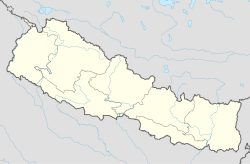|
Chitlang
Chitlang (Nepali: चित्लाङ, Nepal Bhasa: चिलं/चिलिम]) is a village located in Thaha Municipality of Makwanpur District, Bagmati Province, Nepal. Religions of chitlang. The place was formerly called, "Chaityalang" which means, "The road with Chaityas/Stupas". GeographyChitlang lays southwest of Kathmandu valley in the Mahabharat range.[1] The Chitlang is currently in Thaha Municipality is bounded by
HistoryChitlang gaun is located in the ancient Newar settlement. From Kathmandu, the capital city of Nepal, chitlang lays West-South. Inscriptions dating back to the Lichchavi era have been found there. Among Historian, there was confusion of whether Licchavi King Udaydev was throned or not but the inscriptions at Ganeshthan of Chilang Village proved that he was made king at that time.[2] An inscription was found in Toukhel, former Ward 6 of Chitlang VDC, of king Amshubarma (in sambat 37) (now ward no 10 of Thaha Municipality). According to the inscription, Amshubarma had given the land to shepherds and established a settlement for shepherds in Toukhel, Nhulgaun and Kunchhal of Chitlang.[3] Some historians believe that these people, called Gopalis are the descendants of rulers of the Gopal era.[3] Chitlang hosts multiple cultures: the Tamang culture is in former ward no. 1. In ward no. 2 Khas, Newar, Tamang and Brahmin ehtnici group prevail to hold mix culture. In Former wards 3, 4, 5, and 6 the Newari culture is found; of which 5 and 3 wards populated with Balamis where as 4 and 6 is occupied by Gamals+ Deula(Pode) and Gopalis. wards 8, 7 and 9 have a mixed culture. Chitlang celebrates many Jatra and festival throughout the year. It inherits cultures of Patan as once it was under rule of Lalitpur or Patan principalities in Malla era and of Kathmanud as it is proximate to it. During Red Machhendra Nath Jatra at Lalitpur, Puja used to be collected from Chitlang village too. Small temple of Karunamaya or Machhindra Naths still stands at North East to Tahaphale of Chitlang. Similarly, showing its connection to Kathmandu, it celebrates 'yemba thanegu' festival similar to small scale Indra jatra of Kathmandu. The people of chitlang are very friendly and hospitable. You can freely ask them questions related to their history and mythological tales which you will get a detailed answer assuring you about everything you needed to know. Attractions Attractions include "Majhagau" especially (Ashoka chaitya) for Buddhist Community and culture, Swochchhanda Vairav Temple, Satdhara (sat dhara) vendafarm and many homes stays and Resorts including organic village resort. To taste goat cheese from cheese factory may be a list in itinerary. Other Attractions being close to Nature, Hike, Exploring Neighbourhood..[4] DemographicsAccording to the 2013 census of Nepal, Chitland has an approximate population of 7,680 people.[5] The main ethnic populations are Newar, Tamang, Khas and Brahmins. CultureChitlang has a rich Newar culture. The Chitlang dialect of Nepali Bhasa is spoken almost exclusively in this region.[6] The Balami language is one such language. Getting thereThere are several means to reach Chitlang from the capital city and with the introduction of a cable car to the top of the ridge, one can reduce the hike to just going downhill from the top after a short ride. Buses and smaller vehicles leave from Kathmandu and reach Taukhel near Chitlang via Kulekhani. Chitlang is an easy one hour walk from Taukhel. Buses from Hetauda go all the way to Chitlang also via Kulekhani and leave for Hetauda in the morning. Above Thankot is a settlement known as Godam from where some pickup vehicles leave for Chitlang in the morning and go via the Chandragiri pass; it's the shortest route taking about an hour. One set of buses travel via Pharping near Dakshinkali and takes about three hours but don't reach Chitlang, with Taukhel being the closest point. The other vehicles take the old Tribhuvan Highway to reach Kulekhani. The pick-up vehicles to Kathmandu from Chitlang leave in the morning while the bus leaves from Taukhel in the afternoon.[7] Chitlang in Politics and chief AdministratorsThough many settlements of Gopali or Gwala are scattered in Chitlang Area but, foremost inscription of Lichchavi era has been discovered. Once such is the inscription of Chitlang Ganeshthan of Ashuverma Sambat 45 and of same period of Sambat 38 at Taukhel. These inscriptions hints chitlang and its surrounding was ruled/mamaged by Panchalis. Chitlang up to Malla era was under reign of lalitpur or Patan.Direct rule of Patan was what seems dominant at that era. During Shah/Rana Period, various administrative posts like Maha, Nayo, Jimmawal etc. throws light on administrative mamagement. Chitlang formerly under Chisapani Administrative Division of Rana regime fell under Makwanpur District and Narayani Zone after restructuring during Shah Time. Since the Panchat system was introduced in 2017 BS by late king Mahendra, Up to 2022 BS Chitlang has no such formal administrator to facilitate local issues. In year 2022/2023 Chitlang Gaun Panchayat got first Elected Pradhan(Chief) Pancha. Before the country restored to Multiparty Democracy in 2046 BS, Chitlang Gaun Panchayat got 3 Pradhan Panchas in duration of 30 years. The First and Longest Serving one was Late Sundar Man Shrestha, who later became Member of Makwanpur District Panchayat Member. Sudar Man Shrestha also stood as candidate of Rastriya Panchayat held in the year 2038 Bs.
AccommodationThere are several homestays that are controlled by the Home Stay Association (the office is beside the main road) which decides the rates and where the guests should stay.[7] See alsoReferences
|
||||||||||||||||||||||
Portal di Ensiklopedia Dunia


